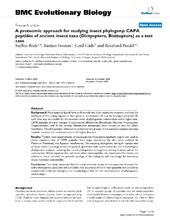A proteomic approach for studying insect phylogeny: CAPA peptides of ancient insect taxa (Dictyoptera, Blattoptera) as a test case
Peer reviewed, Journal article
Peer reviewed

Date
2009-03-03Metadata
Show full item recordCollections
Original version
https://doi.org/10.1186/1471-2148-9-50Abstract
Background: Neuropeptide ligands have to fit exactly into their respective receptors and thus the evolution of the coding regions of their genes is constrained and may be strongly conserved. As such, they may be suitable for the reconstruction of phylogenetic relationships within higher taxa. CAPA peptides of major lineages of cockroaches (Blaberidae, Blattellidae, Blattidae, Polyphagidae, Cryptocercidae) and of the termite Mastotermes darwiniensis were chosen to test the above hypothesis. The phylogenetic relationships within various groups of the taxon Dictyoptera (praying mantids, termites and cockroaches) are still highly disputed. Results: Tandem mass spectrometry of neuropeptides from perisympathetic organs was used to obtain sequence data of CAPA peptides from single specimens; the data were analysed by Maximum Parsimony and Bayesian Interference. The resulting cladograms, taking 61 species into account, show a topology which is in general agreement with recent molecular and morphological phylogenetic analyses, including the recent phylogenetic arrangement placing termites within the cockroaches. When sequence data sets from other neuropeptides, viz. adipokinetic hormones and sulfakinins, were included, the general topology of the cladogram did not change but bootstrap values increased considerably. Conclusion: This study represents the first comprehensive survey of neuropeptides of insects for solely phylogenetic purposes and concludes that sequences of short neuropeptides are suitable to complement molecular biological and morphological data for the reconstruction of phylogenetic relationships.
Publisher
BioMed CentralJournal
BMC Evolutionary BiologyCopyright
Steffen Roth et al.; licensee BioMed Central Ltd.Copyright 2009 Roth et al; licensee BioMed Central Ltd
